Table of Contents
Toggle- Buyers guide to business security camera systems
- Key features of business security camera systems
- How to choose the right business security camera system
- Best business security cameras to use
- More details on business security cameras
- Video management systems (VMS) best for business security cameras
- Choosing the right storage for your business security camera system
- the best places to put your business security cameras
- Business security camera systems frequently asked questions
- What does CCTV stand for?
- What are the best security cameras for a business?
- How much does a business security camera system cost?
- What are the top types of CCTV cameras?
- How much does it cost to install cameras in a business?
- How many security cameras do I need for my business?
- Can security cameras be a business expense?
- Which is better, wireless or wired CCTV cameras?
- What is the difference between CCTV and security cameras?
- Which CCTV camera is better, HD or IP?
- What is the best security system for the money?
- Do security cameras use a lot of electricity?
- Does having security cameras lower business insurance?
- What is NVR vs DVR?
- Can wireless cameras work without the Internet?
- Is there a security camera that records continuously?
- Is there a security camera that will record if WiFi goes out?
- How long do business security cameras keep footage?
- What is the longest distance for a security camera?
- What is the difference between security cameras and surveillance cameras?
- Do security cameras record in the dark?
- Do motion sensor cameras record all the time?
- Do you need WiFi for a security camera?
- Are white or black security cameras better?
- How do I choose a good security camera?
- How much area can a CCTV camera cover?
- Do security cameras record audio?
- Are security cameras recording if they have no lights?
- How do you tell where a security camera is aimed?
- Are security cameras an invasion of privacy?
- What type of security cameras do businesses use?
- What is the best security camera 2022?
- What security cameras cannot be hacked?
- How much is a security system for a restaurant?
- What are the two types of security cameras?
- Is 4K or 1080p better for security cameras?
- Why are 360 cameras sometimes called fisheye cameras?
- Solink completes your business security camera system
Buyers guide to business security camera systems
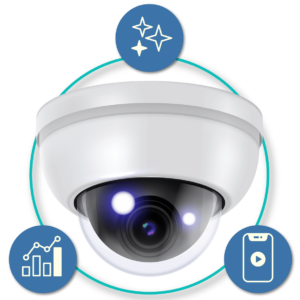 Choosing the right business security camera system is crucial for protecting your assets, employees, and customers. With so many options available, it’s important to understand key features like camera types, storage solutions, and system integrations.
Choosing the right business security camera system is crucial for protecting your assets, employees, and customers. With so many options available, it’s important to understand key features like camera types, storage solutions, and system integrations.
This guide will help you find the best security system for your business—whether you operate a retail store, restaurant, or office—so you can enhance safety, prevent theft, and gain valuable insights. Keep reading to make an informed decision.
See how Solink can help you build a powerful commercial security camera system for your sites.
The evolution of business security camera systems
Business security camera systems have come a long way from grainy footage and bulky hardware. What started as simple, wired cameras with limited recording capabilities has transformed into smart, cloud-connected solutions with AI-powered analytics.
Today, businesses can monitor multiple locations in real time, access footage from anywhere, and integrate cameras with other security and operational systems. These advancements improve safety, reduce theft, and provide valuable business insights.
Understanding this evolution helps businesses choose the right security system—one that’s not just about recording but about smarter protection and better decision-making.
Why business security camera systems are so important
A business security camera system is more than a theft deterrent—it’s a critical tool for protecting assets, employees, and operations. With rising risks like shoplifting, internal theft, fraudulent claims, and workplace violence, businesses need reliable surveillance to prevent losses and ensure a safe environment.
Modern security cameras offer high-definition video, real-time alerts, and remote access, allowing business owners to monitor activity from anywhere. AI-powered analytics can detect suspicious behavior, reduce false alarms, and provide insights that improve efficiency and customer service.
Whether you run a retail store, restaurant, or corporate office, a business security camera system enhances security, strengthens accountability, and gives you peace of mind—helping your business run smoother and safer.
Key features of business security camera systems
Choosing the right business security camera system means understanding its core components. Here are three key features to consider:
1. Cameras
The type of cameras you choose determines the clarity, coverage, and functionality of your system. Options include:
- Indoor vs. outdoor: Weather-resistant cameras for exterior monitoring
- Dome, Bullet, or PTZ: Different shapes for different needs—discreet, long-range, or adjustable views
- AI-Powered & Smart Features: Motion detection, facial recognition, and heat mapping for better insights
2. Video Management System (VMS)
A VMS is the software that controls your cameras, stores footage, and allows you to review and manage video. Key features include:
- Remote access: View live or recorded footage from any device
- Search & alerts: Quickly find incidents and receive real-time notifications
- Integration: Connect with POS, access control, or alarm systems for a complete security solution
3. Storage options
Where and how footage is stored impacts accessibility and retention. Common storage solutions include:
- Cloud storage: Secure, scalable, and accessible from anywhere
- On-premises (NVR/DVR): Local storage with full control over data
- Hybrid solutions: A mix of cloud and on-site storage for flexibility and redundancy
A well-designed business security camera system combines the right cameras, VMS, and storage to provide clear visibility, efficient management, and long-term security.
How to choose the right business security camera system
Finding the best business security camera system starts with understanding your specific security needs. Consider what areas need monitoring—indoors, outdoors, or both—and whether you require features like night vision, motion detection, or AI-powered analytics. Integration with other systems, such as POS, alarms, or access control, can also enhance security and operational efficiency.
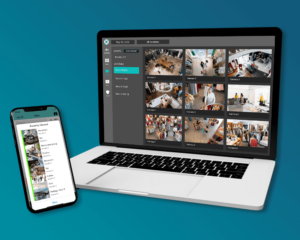 Choosing the right cameras is key. Dome cameras provide discreet, wide-angle coverage, while bullet cameras offer long-range visibility. PTZ (pan-tilt-zoom) cameras allow flexible adjustments for larger spaces, and smart cameras with AI capabilities can track movement and recognize faces for added security.
Choosing the right cameras is key. Dome cameras provide discreet, wide-angle coverage, while bullet cameras offer long-range visibility. PTZ (pan-tilt-zoom) cameras allow flexible adjustments for larger spaces, and smart cameras with AI capabilities can track movement and recognize faces for added security.
Your video management system (VMS) determines how you control and access footage. A good VMS should offer remote access, allowing you to view video from any device. Search and alert functions help you quickly find incidents, while integration with other business systems streamlines security management.
Storage is another critical factor. Cloud storage provides secure, scalable access from anywhere, while on-site storage (NVR/DVR) keeps data under your control without relying on an internet connection. Hybrid solutions combine both options for flexibility and redundancy.
Finally, think about scalability. As your business grows, your security system should easily expand with additional cameras and upgraded software. Investing in the right business security camera system now ensures long-term protection, better decision-making, and peace of mind.
Best business security cameras to use
There are many different types of business security cameras. Let’s break down all the specific definitions.
CCTV cameras
Closed-circuit television (CCTV) is simply the opposite of broadcast TV. Whereas broadcast is aimed at sending video to many subscribers, CCTV transmits video to a small number of places. CCTV is sometimes synonymously used with video security for this reason.
Business CCTV security cameras originally sent their video to the security office locally, but now they are usually connected to the Internet so their footage can be viewed remotely by more stakeholders, including managers, loss prevention specialists, insurance companies, and even emergency services dispatchers.
Analog cameras
Analog cameras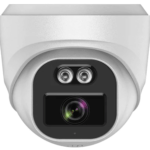 can sometimes be considered old technology when compared to newer IP cameras. For example, analog security cameras are usually capped to standard definition (SD) video quality. However, they tend to be reliable and have been the mainstay of video security for decades. They normally require a coaxial cable connection to transmit video along with a power cord, but RF wireless analog cameras are also available. While you may wish to direct your procurement department to make future security camera purchases digital, it doesn’t mean you need to replace current analog security cameras. Solink can work with most IP and analog cameras, so there’s no need to upgrade your entire business security camera infrastructure to work with our platform.
can sometimes be considered old technology when compared to newer IP cameras. For example, analog security cameras are usually capped to standard definition (SD) video quality. However, they tend to be reliable and have been the mainstay of video security for decades. They normally require a coaxial cable connection to transmit video along with a power cord, but RF wireless analog cameras are also available. While you may wish to direct your procurement department to make future security camera purchases digital, it doesn’t mean you need to replace current analog security cameras. Solink can work with most IP and analog cameras, so there’s no need to upgrade your entire business security camera infrastructure to work with our platform.
TVI cameras
Transport video interface (TVI) is a way of transmitting analog video over a coaxial cable. It is one of several different technologies used to push analog cameras into high definition (HD).
The better definition is only the first of the two main goals accomplished by TVI. The other is the longer wired transmission range. Standard analog security cameras (sometimes called CVBS for composite video baseband signal) have a maximum wired transmission range of 300 ft. Some of these newer ones, including TVI, have ranges up to 900 ft.
Bullet cameras
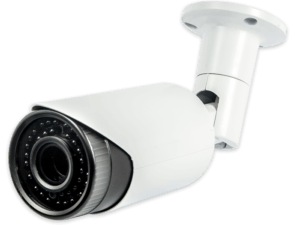 Bullet cameras are some of the most common business security cameras on the market. They are small and get their name from their shape. It’s also why they are sometimes called “lipstick cameras.”
Bullet cameras are some of the most common business security cameras on the market. They are small and get their name from their shape. It’s also why they are sometimes called “lipstick cameras.”
Their small size and easy installation make them particularly versatile. You can find them indoors and outdoors, and they are usually less noticeable than larger security cameras (e.g., the turret security cameras discussed next). However, their shape makes them less robust to vandalism than dome cameras (see below). Some bullet cameras have varifocal lenses, allowing one to adjust the field of view of the camera without losing picture quality. However, you will need to make any adjustment on the camera manually.
See more about bullet vs. turret cameras here.
Turret cameras
Turret security cameras have a ball-and-socket design. Within the “turret”, the ball-like camera can be positioned to look at different angles. This makes their installation and re-positioning flexible. However, once installed, you’ll need to physically reposition the camera to get a new field of view.
IP cameras
Internet protocol cameras (IP cameras) are controlled using an IP network and transmit data digitally. By using the IP networking standards, some IP cameras can work without needing any local storage. However, regulations may require you to keep storage on premise regardless. Furthermore, Internet bandwidth is not always perfectly stable, so having cloud and/or on premise storage is considered a more reliable system.
IP cameras can connect to a network in two main ways: WiFi or a power over Ethernet (PoE) cable. PoE cables provide both power and network access for transmission and reception. If WiFi is chosen, then the cameras will still need to be powered, either using a battery or being plugged in through an adapter. WiFi cameras can also be less reliable as video feeds may be temporarily unavailable when the connection is spotty or because of interference.
Dome cameras
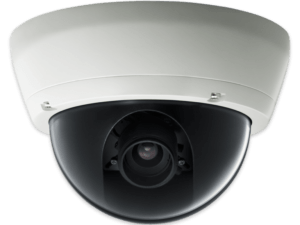 Dome cameras are cameras covered with a dome. This obscures the direction they are facing, which can make employees and customers less sure what is or is not in the camera’s field of view. Their shape and the dome protection make them more resistant to vandalism.
Dome cameras are cameras covered with a dome. This obscures the direction they are facing, which can make employees and customers less sure what is or is not in the camera’s field of view. Their shape and the dome protection make them more resistant to vandalism.
However, as with many of the other cameras on this list, it has a fixed viewing angle that cannot be changed remotely.
See more about dome cameras vs. bullet cameras here.
Wireless cameras
Wireless business security cameras transmit the video feed wirelessly. They still require power. Although there are battery- or solar-powered security cameras, they tend to only be used where electricity is impractical.
Both digital and analog business security cameras can be wireless.
Wireless analog cameras
Wireless analog cameras connect to the network using an RF signal. Note that RF signals are less reliable than WiFi because cell phones and other nearby devices can interfere with the signal.
Wireless digital cameras
Wireless digital (IP) cameras connect to the network via WiFi. These signals are very robust to noise but have a more limited range, so wireless digital cameras can be considered more reliable than analog ones.
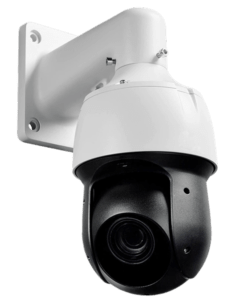 PTZ cameras
PTZ cameras
PTZ stands for pan, tilt, zoom, and that’s basically what they can do. PTZ security cameras can be controlled remotely to pan across a larger area or zoom in on something in particular.
This added functionality usually comes with a higher price tag. However, you might be able to offset the added cost per camera by using fewer cameras in total. Remember, though, PTZ cameras are only recording what the lens is facing. Additionally, the PTZ feature is mechanical, which is often a weak point in these cameras.
Learn more about PTZ cameras vs. 360 cameras here.
360 degree cameras (fisheye cameras)
Fisheye cameras can be considered the next step in the evolution of business security cameras. PTZ cameras improve on the base turret cameras by allowing the user to change the viewing angle remotely. Fisheye cameras go even further by giving the user a complete 360° by 180° view all of the time. This makes them great options for monitoring large open areas, such as a warehouse.
360 degree cameras get their nickname of fisheye cameras due to the distorted image shown. However, using modern gaming technology, Solink stretches out this view to give you an immersive look at what is happening at your site. Here’s the 360 camera at work with Solink: While the PTZ camera requires a loss prevention guard to be on duty watching the camera feed to change the view angle, 360 degree cameras show and record everything all the time. We’ve found that a single 360 degree security camera can replace four to six traditional security cameras in wide open areas.
Want a personalized demo?
More details on business security cameras
Business security camera systems are complex. There are a lot of decisions to be made on the components. Here’s a list of common comparison points.
WiFi vs. Ethernet
The first thing to remember when comparing WiFi vs. ethernet is that this only means a camera is wireless vs. wired for data transmission. WiFi cameras still require energy to work, and that energy usually comes from being plugged into a socket.

However, PoE (power over Ethernet) provides energy and transmission in a single Cat 5 Ethernet cable. That means that WiFi and PoE security cameras are both still going to have one wired connection.
While WiFi is generally considered robust to noise, it is never going to be as fast, robust, or secure as Ethernet. Furthermore, WiFi has a limited range: usually about 50 feet before the signal becomes too weak for reliable video transmission; depending on the number and types of obstacles between the router and cameras, this distance can be reduced. Ethernet cables, used for IP cameras, can reliably be used at distances over 300 feet.
SD vs. HD vs. 4K
Standard definition (SD), high definition (HD), and 4K refer to the resolution at which your business security cameras record footage. Classical analog cameras record in SD, but there are some HD analog security cameras on the market. Conversely, IP cameras have at least HD and sometimes even 4K resolution.

Resolution at its core is how many pixels are recorded in an image. Here’s a summary of the different resolutions:
- SD usually refers to resolutions below 720×480 pixels
- HD usually refers to 1280 x 720 or 1920 x 1080 pixels.
- 4K refers to 3840 x 2160 to 4096 x 2160 pixels.
Pixels are little color dots, and more of them mean the dots are closer together and therefore you can see more details. This might lead you to believe that higher resolution is always better. However, there are several other considerations that should be included in your decision-making process.
Field of view
A camera’s field of view is the angle width (and height) that it is recording. Business security cameras have a wide range of fields of view. They can be as low as 40° for zoomed-in smaller cameras and go up to 360° by 180° for a 360 degree business security camera.
The FOV/resolution combination of your cameras dictates the final quality of the video. With the same resolution, a lower field of view will show more details than a larger angle. For this reason, 360 cameras usually have a much higher resolution than other regular cameras
Plug-in cameras vs. battery-powered cameras
Battery-powered security cameras absolutely exist. However, their use cases are generally reserved for areas without local electricity connections. In areas where a security camera can be plugged in and/or where continuous 24/7 video recording is required, charging the battery regularly would cause more trouble than any time saved installing a power cord (or PoE connection).

Battery-powered security cameras that only function when triggered, for example by a motion sensor, can last several months on a single charge depending on the level of motion happening in their field of view, so in remote locations with lower security needs they could be useful, but in most situations they are not recommended.
IP camera vs. analog cameras
IP security cameras send digital video over Ethernet or WiFi connections, whereas analog cameras send analog video over a coaxial cable. This is the major difference between them, but there are more.

Analog security cameras tend to be SD or HD (e.g., TVI security cameras), whereas IP security cameras are at least HD and are also available in very high resolution. Solink can provide VSaaS solutions to companies using both analog and IP security cameras. IP security cameras can provide richer data, but analog cameras are not yet completely obsolete. Working with your existing business security camera system infrastructure is a major benefit of Solink as it lowers your startup costs.
Power over Ethernet (PoE)
PoE eliminates the need for separate power and data cabling. This is a major benefit of IP security cameras over analog ones.
System cost
IP security cameras are on average more expensive than analog ones. In addition, IP cameras are easier and cheaper to install since they only need an Ethernet cable where analog cameras require a power supply cable and a coaxial cable for the signal. These features combined mean that, when buying a new business security camera system, purchasing IP security cameras is generally comparable to or even cheaper than buying an analog security camera system and also future proofing your system for upcoming improvements.
Video management systems (VMS) best for business security cameras
A video management system (VMS) is the backbone of any business security camera system, allowing you to monitor, store, and manage video footage efficiently. The right VMS provides real-time access to live and recorded video, advanced search capabilities, and seamless integration with other security and business systems.
Whether you need basic video storage or an AI-powered platform with analytics, choosing the best VMS ensures better security, faster incident response, and improved operational insights. Understanding your business needs will help you select a system that offers the right balance of control, scalability, and ease of use.
Top features to look for in a VMS for business security cameras
Here is a list of the top features to look for in a VMS for you business security cameras. Keep in mind these are all features Solink offers and you’d like to experience what they are all like in person don’t hesitate to book a demo with out team and see what it’s all about.
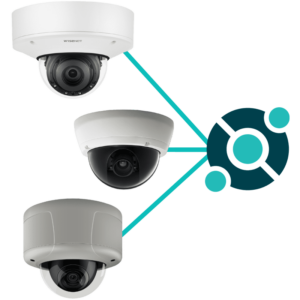 The ability to use your existing cameras
The ability to use your existing cameras
Upgrading your business security camera system doesn’t always mean replacing your existing cameras. Many modern video management systems (VMS) support a wide range of camera brands and models, allowing you to integrate current hardware with new software for enhanced functionality.
By leveraging your existing cameras, you can reduce costs while gaining advanced features like remote access, AI-powered analytics, and better storage options. Compatibility is key, so choosing a VMS that supports open-platform integration ensures a seamless transition and maximizes your security investment.
Remote monitoring and camera health checks
A modern business security camera system should do more than just record—it should keep you informed in real time. Remote monitoring allows you to access live and recorded footage from anywhere, ensuring you always have visibility into your business operations. Whether you’re checking in from a smartphone, tablet, or computer, a cloud-connected system provides instant access and alerts.
Beyond monitoring, camera health checks ensure your system is always working. Automated diagnostics can detect offline cameras, storage failures, or connectivity issues, reducing downtime and security gaps. With proactive alerts and maintenance insights, you can keep your security system running smoothly without constant manual checks.
Easy save and search functions
A business security camera system is only as useful as its ability to quickly retrieve important footage. Easy save and search functions allow you to find and store video clips effortlessly, reducing the time spent scrolling through hours of recordings.
Advanced search features, such as motion detection, AI tagging, and keyword-based filtering, help pinpoint specific events in seconds. Cloud-based systems often include automatic backups, ensuring critical footage is never lost. With a user-friendly interface and smart search capabilities, you can quickly access the video you need—when you need it.
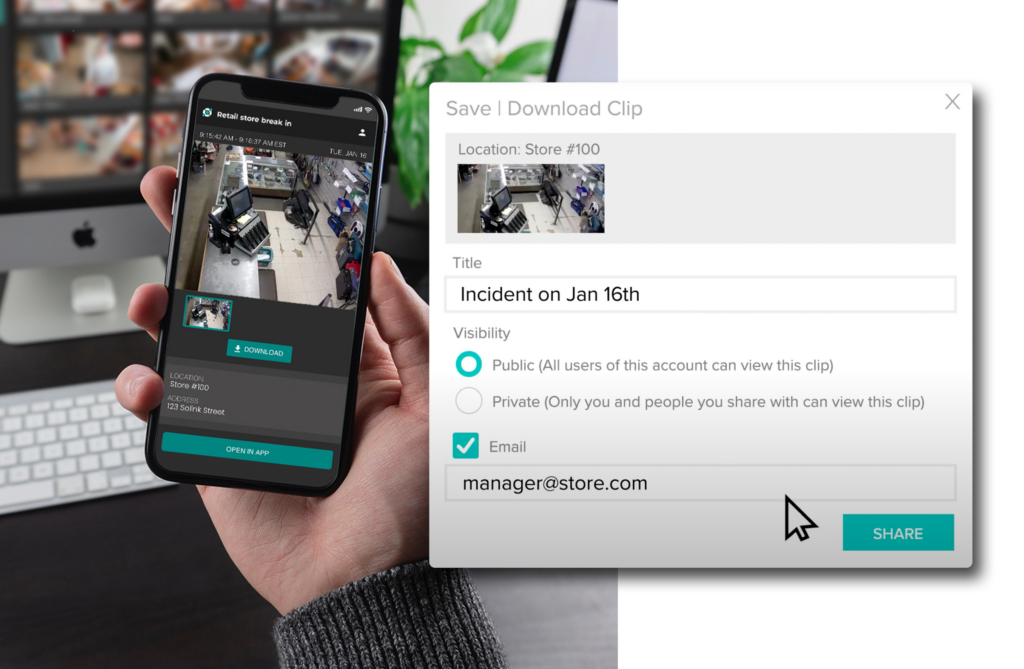
The ability to turn your cameras into alarms…video alarms
A business security camera system can do more than just record—it can actively prevent incidents. With video alarms, your cameras become real-time security sensors, detecting motion, unauthorized access, or unusual activity and triggering instant alerts.
AI-powered detection helps reduce false alarms by distinguishing between routine movements and actual threats. When an alarm is triggered, you can receive notifications, activate deterrents like lights or audio warnings, or escalate the issue to security personnel. By transforming cameras into proactive security tools, video alarms enhance protection and response times, keeping your business safer.
Personalized notification setup
A business security camera system should keep you informed without overwhelming you with alerts. Personalized notification setup allows you to tailor alerts based on specific events, times, or locations, ensuring you receive only the most relevant updates.
Whether it’s motion detection after hours, access to restricted areas, or unusual activity at a cash register, smart notifications let you stay in control. Choose to receive alerts via email, text, or app notifications, so you can respond quickly when it matters most. With a customized setup, your security system works for you—providing the right information at the right time.
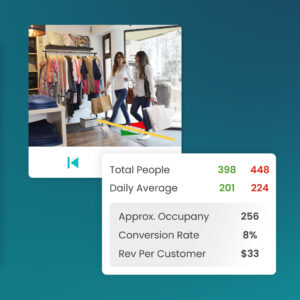 AI-powered capabilities and video analytics
AI-powered capabilities and video analytics
A modern business security camera system goes beyond recording—it provides real-time intelligence. AI-powered capabilities and video analytics help businesses detect threats, monitor trends, and improve operations.
Features like motion tracking, facial recognition, and object detection reduce false alarms and identify security risks faster. Advanced analytics can also track customer behavior, optimize staffing, and detect suspicious activity before it becomes a problem.
With AI-driven insights, businesses gain more than just security—they get valuable data to enhance safety, efficiency, and decision-making.
24/7 support and easy installation
Easy installation ensures a smooth setup, whether you’re using existing cameras or installing a new system. Cloud-based solutions often require minimal hardware, reducing downtime and technical headaches.
Ongoing reliability matters just as much. With 24/7 support, you have expert assistance whenever you need it—whether it’s troubleshooting a connection issue, adjusting settings, or ensuring your system is running smoothly. A security system should provide peace of mind, and round-the-clock support makes sure it always does.
Choosing the right storage for your business security camera system
Storage is a crucial part of any business security camera system, determining how long you can retain footage and how easily you can access it. The right option depends on your business size, security needs, and budget.
Cloud storage offers remote access, automatic backups, and scalable retention, making it ideal for businesses needing flexibility and off-site security. On-premises storage, such as NVRs or DVRs, provides full control over data without relying on an internet connection. Hybrid storage combines both, ensuring redundancy and reliability.
Choosing the best storage solution ensures your security footage is always available when you need it, without unnecessary costs or risks.
Cloud vs. on-site storage
Choosing between cloud and on-site storage for your business security camera system depends on your needs for accessibility, security, and cost. Each option has advantages, and the right choice depends on your business operations.
Cloud storage offers remote access, automatic backups, and scalability. Footage is stored securely off-site, protecting it from hardware failures or tampering. It’s ideal for businesses that need flexibility and multi-location access without managing physical servers.
On-site storage (NVR/DVR) keeps data under your control, without relying on internet connectivity. It’s a good option for businesses with high data usage or strict security policies that require footage to remain in-house.
For the best of both worlds, hybrid storage combines local reliability with cloud accessibility, ensuring redundancy and security without sacrificing convenience.
Hybrid video storage solutions – best of both worlds
A hybrid video storage solution combines the benefits of both cloud and on-site storage, giving businesses greater flexibility, security, and reliability.
With hybrid storage, critical footage is stored locally for quick access, while cloud backups ensure long-term retention and protection against hardware failures or tampering. This approach reduces the risk of data loss while allowing remote access to key video files when needed.
For businesses that require both control and scalability, hybrid storage provides the perfect balance—offering the security of local storage with the convenience and redundancy of the cloud.
Factors to help you choose video storage for your business
Selecting the right video storage for your business security camera system depends on several key factors. Understanding your needs ensures you choose a solution that balances security, accessibility, and cost.
- Retention period: How long do you need to keep footage? Some industries require specific retention policies for compliance.
- Storage capacity: The number of cameras, video quality, and recording duration affect how much storage you need.
- Accessibility: Cloud storage allows remote access, while on-site storage keeps data within your network. Hybrid options offer both.
- Security & redundancy: Cloud backups protect against theft or hardware failure, while local storage ensures immediate access.
- Cost & scalability: Cloud solutions offer flexible pricing, while on-premises systems require upfront investment but no monthly fees.
By considering these factors, you can choose a storage solution that keeps your footage secure, accessible, and cost-effective.
the best places to put your business security cameras
Placing the cameras in your facilities is a key step in building a strong business security system. We’ve discussed some of the issues you need to keep in mind when doing this in a restaurant previously, but now we share with you a complete business security camera floor plan.
Take a look at the business security camera floor plan below. Note that, if you click on it, you can see a much higher resolution version.
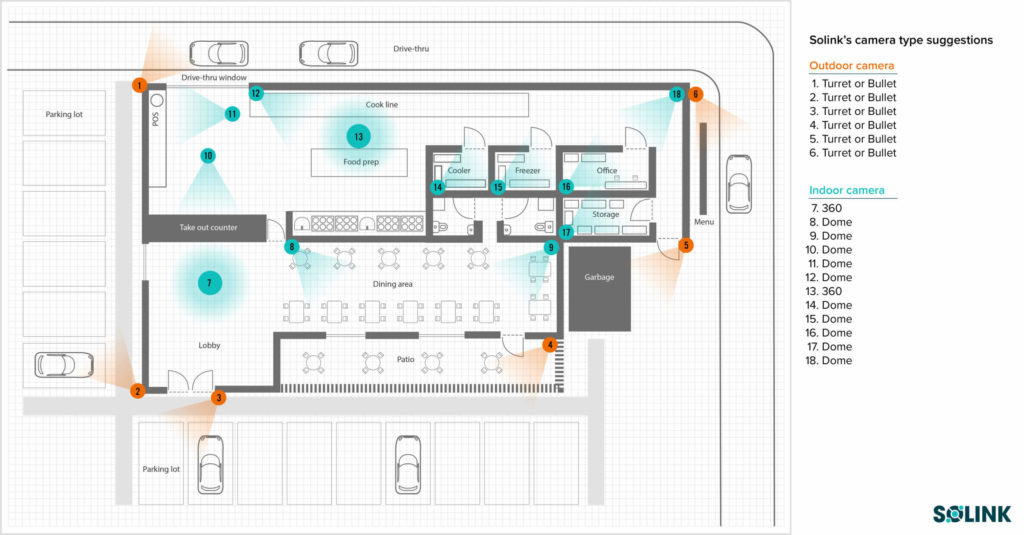
The following table summarizes the camera type, location, and reason for the coverage. The full reasoning behind this business security camera floor plan can be found here.
| Outdoor cameras | |||
| Number | Camera Type | Location | Purpose |
| 1 | Turret or bullet | Drive thru | Monitor drive thru speed of service |
| 2 | Turret or bullet | Walkway/parking lot | Monitor slip-and-falls and traffic |
| 3 | Turret or bullet | Walkway/parking lot | Monitor slip-and-falls and traffic |
| 4 | Turret or bullet | Patio | Protect patrons |
| 5 | Turret or bullet | Backdoor/garbage | Perimeter defense |
| 6 | Turret or bullet | Drive thru | Monitor drive thru speed of service |
| Indoor cameras | |||
| Number | Camera Type | Location | Purpose |
| 7 | 360 | Lobby | Protect patrons |
| 8 | Dome | Dining area | Protect patrons |
| 9 | Dome | Dining area | Protect patrons |
| 10 | Dome | Takeout counter | Monitor delivery services |
| 11 | Dome | POS | Monitor transactions and cash activity |
| 12 | Dome | Cook line | Monitor food safety |
| 13 | 360 | Food prep area | Monitor food safety |
| 14 | Dome | Freezer | Inventory security |
| 15 | Dome | Freezer | Inventory security |
| 16 | Dome | Office | Safe security |
| 17 | Dome | Storage room | Inventory security |
| 18 | Dome | Office entrance/backdoor | Safe security and perimeter defense |
While a single reason for the placement of each camera is listed in the table, the truth is that all of these cameras are performing multiple functions. Please view the complete report to see just how much value beyond security that your security cameras could be providing. Notice that turret or bullet cameras are used outdoors because they are designed to endure harsh environments. Indoors, a combination of dome and 360 degree cameras are used. The domes provide a similar field of view to turrets or bullets, but the direction the camera is facing is hidden, which adds a bit more security value. The 360 degree cameras are placed in the most open areas to monitor the whole lobby and kitchen.
Business security camera systems frequently asked questions
Here are some frequently asked questions (FAQs) about business security camera systems.
What does CCTV stand for?
CCTV stands for closed-circuit television. CCTV is often used to refer to security cameras, as unlike broadcast TV the footage is not distributed widely. Note that some people only use CCTV to refer to analog cameras, while others refer to all security cameras as CCTV cameras.
What are the best security cameras for a business?
Solink can work with a variety of camera types and brands. Hanwha and Axis cameras are two well-regarded brands.
How much does a business security camera system cost?
The price of a business security camera system will depend on how many cameras are required, the types of cameras deployed, how long the video needs to be retained, and several other factors.
What are the top types of CCTV cameras?
There are many different types of security cameras. Some of the commonly used types of security cameras are the following:
- Bullet cameras
- Turret cameras
- Dome cameras
- PTZ cameras
- 360 cameras
How much does it cost to install cameras in a business?
The price of installing security cameras will depend on the types of cameras used. Wireless battery-powered cameras can be installed easily by the user, whereas Power over Ethernet (PoE) cameras may require running new wires. Solink can install cameras or work with a preferred local installer, which reduces the cost of installing security cameras.
How many security cameras do I need for my business?
The type of business and the local risks will dictate how many cameras your business requires. Before deciding on a camera layout, it is recommended that you have a professional walk through your business and advise on the types of cameras you need and where they should be placed.
Can security cameras be a business expense?
Yes. Security cameras are definitely a business expense.
Which is better, wireless or wired CCTV cameras?
Wireless CCTV cameras are easier to install, but wired CCTV cameras tend to be more reliable and require less maintenance. In most cases, Solink recommends wired CCTV cameras.
What is the difference between CCTV and security cameras?
Closed-circuit television (CCTV) camera is another way of saying security camera. Closed-circuit in this case indicates the opposite of broadcast, as security camera footage is not widely distributed.
Which CCTV camera is better, HD or IP?
Internet protocol (IP) cameras use a local WiFi or Ethernet network to transmit video digitally. High-definition (HD) video refers to the quality of the video feed measure in the number of pixels. Most IP cameras can record in HD quality or better.
What is the best security system for the money?
It’s important to go beyond security cameras and have a complete security system. This includes an integrated video analytics system that can pair video with other data, such as point of sale (POS) transactions or motion events. This saves the operator time, makes it easy to share evidence with law enforcement, and increases the likelihood that theft events will be found, generating greater return on investment (ROI).
Do security cameras use a lot of electricity?
The average security camera consumes 2–10 W of power, which is about 1.5–7 kWh per month. The American national average price of energy is $0.18/kWh, which means the average security camera costs about $0.25–1.35 in energy per month.
Does having security cameras lower business insurance?
Security cameras can reduce the risk profile of a company. If a company has fewer claims by minimizing theft events, then they will likely experience lower overall insurance costs. In addition, security cameras can prevent fraudulent injury or damage claims by recording evidence, which can again reduce insurance costs.
What is NVR vs DVR?
DVR (digital video recorder) and NVR (network video recorder) find their distinction in how they receive video data. DVRs receive raw data captured from analog cameras. The signal is processed on the DVR before being recorded. Conversely, NVRs do not process the signal they receive. The video signal is processed by the camera before being sent to the NVR.
Can wireless cameras work without the Internet?
Wireless cameras need to broadcast their video over the local WiFi network. If you have local video storage, or the camera has local storage, then a wireless camera should continue to record during an Internet outage.
Is there a security camera that records continuously?
Most security cameras are able to record continuously provided you have sufficient storage space. Solink also provides the option of time-based recording if you need to pause recording on a schedule due to privacy concerns. This is especially important for businesses that share their space, for example a daycare inside of a community center.
Is there a security camera that will record if WiFi goes out?
Power over Ethernet (PoE) provides both power and a direct wired connection to security cameras. Since they transmit video over Ethernet, they can continue to record video even when the WiFi goes out.
How long do business security cameras keep footage?
Different businesses have different video retention needs. Solink offers a customizable retention period. Most businesses choose 30, 60, or 90 days, but some regulated industries can mandate a full year of video retention.
What is the longest distance for a security camera?
The type and quality of the lens will dictate how far away can be clearly recorded by a camera. Some 4K turret cameras can clearly see a license plate in ideal lighting at several hundred feet.
The transmission limit from the camera to the video storage device is determined by the type of transmission. Ethernet can transmit the data the farthest, coaxial cables have a shorter transmission capability, while WiFi has the shortest transmission range.
What is the difference between security cameras and surveillance cameras?
Security cameras and surveillance cameras are the same thing. People will use the names depending on what they want to emphasize.
Do security cameras record in the dark?
Some security cameras have built in infrared LED lights that allow them to record in the dark. More infrared LED lights is an indication of better nighttime recording capability.
Do motion sensor cameras record all the time?
Some DIY security systems can be set to only record when motion is detected. Business security cameras generally record all the time.
Do you need WiFi for a security camera?
There are WiFi security cameras. However, most security cameras use Power over Ethernet (PoE) connections to both power the camera and transmit the video to the local storage system. PoE security cameras are more reliable than WiFi security cameras, so Solink recommends you use them wherever possible.
Are white or black security cameras better?
The color you choose for your security cameras has no impact on their capabilities. You may choose a particular color to make the security blend into the background or make it stand out more, depending on your preference.
How do I choose a good security camera?
It can be difficult to choose good security cameras. One thing you may want to consider is whether the cameras are able to integrate with your other systems.
How much area can a CCTV camera cover?
How much area that a security camera can cover will depend on the type of lens. For example, a 360 camera can cover as much area as 4–6 bullet cameras.
Do security cameras record audio?
Not all security cameras record audio, but there are models that do record sound if this is important for your business.
Are security cameras recording if they have no lights?
It can be difficult to tell if a security camera is recording from looking at it. This helps the deterrence value of security cameras as would-be thieves assume they are recording all the time.
How do you tell where a security camera is aimed?
It is easy to see where bullet cameras are pointing. Dome cameras obfuscate this information, so people can’t tell where the camera is pointing. Fisheye cameras are actually recording in all directions at all times.
Are security cameras an invasion of privacy?
No. People should not expect privacy in public places, so security cameras may be placed freely in businesses. However, bathrooms, changerooms, and some other areas do have assumed privacy, so security cameras cannot be placed in these locations.
What type of security cameras do businesses use?
Businesses use many different types of security cameras depending on the type of area that needs to be surveilled. Bullet, turret, dome, PTZ, and 360 cameras are the most commonly used types of security cameras.
What is the best security camera 2022?
There are many great security camera brands. Hanwha and Axis cameras, for example, are considered very reliable.
What security cameras cannot be hacked?
Unfortunately, all devices connected to the Internet, sometimes collectively known as the Internet of Things (IoT), could be hacked. That’s why cybersecurity must be part of physical security.
How much is a security system for a restaurant?
Every restaurant is different, so the number and type of cameras required will also be different. Here’s a great guide to restaurant security cameras.
What are the two types of security cameras?
The two main types of security cameras are analog and Internet protocol (IP) security cameras. While IP cameras are the better technology, analog cameras can still have value and do not necessarily need to be replaced before they reach a natural end of life (EoL).
Is 4K or 1080p better for security cameras?
4K cameras offer sharper images than 1080p or 720p cameras. However, that leads to higher data usage. The best security camera is the one that fits the needs of the business, which might be high-quality 4K cameras or standard definition ones.
Why are 360 cameras sometimes called fisheye cameras?
Some people refer to 360 cameras as fisheye cameras because the video has a distorted look like a fisheye lens. However, Solink uses advanced gaming technology to stretch out the view and provide an immersive experience.
Solink completes your business security camera system
To get the most out of your security cameras, you need to connect them to a complete video security ecosystem. That includes Solink’s video analytics.
Book a demo to learn more about how Solink’s AI can help you stay ahead of security threats.
Schedule a product demo with our experts

